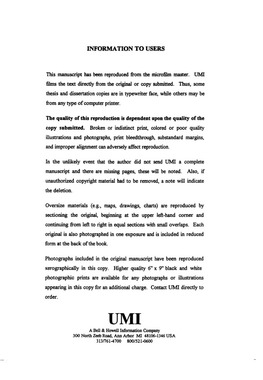| dc.contributor.advisor | Nagle, David P., Jr., | en_US |
| dc.contributor.author | Parekh, Manish M. | en_US |
| dc.date.accessioned | 2013-08-16T12:29:30Z | |
| dc.date.available | 2013-08-16T12:29:30Z | |
| dc.date.issued | 1997 | en_US |
| dc.identifier.uri | https://hdl.handle.net/11244/5425 | |
| dc.description.abstract | Studies of the effect of temperature on stability of 100-fold purified HGPRTase from M. thermoautotrophicum suggested that this enzyme is the most thermostable of all known HGPRTases; upon incubation at 92$\sp\circ$C followed by assay at 55$\sp\circ$C, the half life of HGPRTase activities was 4 min without substrate PRPP$\rm\sb{i}$ and greater than 23 min with it. The temperature optimum for methanogen HGPRTase was between 71 and 79$\sp\circ$C, with most of its activity remaining at 88$\sp\circ$C. Notably, HGPRTase activities from the mesophiles Escherichia coli (eubacterium) and Saccharomyces cerevisiae (yeast) were also highly active at 92$\sp\circ$C. | en_US |
| dc.description.abstract | HGPRTase from M. thermoautotrophicum was purified greater than 1200-fold. The subunit molecular weight of HGPRTase was determined to be 28 kDa. 100-fold-purified enzyme was active over a broad pH range (optimum pH 9.9). The apparent $K\sb{\rm m}$ values for hypoxanthine, guanine, and PRPP$\rm\sb{i}$ were 6.1 $\mu$M, 38.7 $\mu$M, and 86.3 $\mu$M, respectively. HGPRTase was stimulated by Mg$\sp{2+}, $ Mn$\sp{2+}$, and Zn$\sp{2+}, $ but inhibited by IMP and PP$\rm\sb{i}.$ Growth in the presence of acetate but not purine bases yielded a two-fold increase in the levels of HGPRTase in extracts. The NH$\sb2$-terminal amino acid sequence of the peptide assigned to M. thermoautotrophicum HGPRTase was Met-Leu-Asp-Lys-Leu-Lys-Glu-Ser-Leu-Arg-Asn-Ser-Pro-Val-Ile-Lys- Lys-Gly-Glu-Tyr. | en_US |
| dc.description.abstract | Viability studies of effects of starvation on M. thermoautotrophicum under different gas phases (H$\rm\sb2, \ N\sb2, $ and N$\sb2$:CO$\sb2)$ suggested that it remained viable under N$\sb2$:CO$\sb2, $ but lost viability much more rapidly under H$\sb2$ or N$\sb2.$ Incubation of cells under N$\sb2$:CO$\sb2$ with inhibitors neomycin or 5-methyl tryptophan resulted in more rapid loss of viability than for cells without compound. This suggests that protein synthesis may be involved in survival of M. thermoautotrophicum. | en_US |
| dc.description.abstract | This dissertation describes a genetic and biochemical study of purine metabolism in Archaea and is expected to contribute to our knowledge about enzymes and pathways involved in salvage of purine bases. Methanobacterium thermoautotrophicum mutants spontaneously resistant to purine analogs were isolated. All mutants resistant to a hypoxanthine analog or a guanine analog were cross-resistant to analogs of the other base. These mutants lacked the ability to incorporate both purine bases (hypoxanthine or guanine), and were deficient in hypoxanthine and guanine phosphoribosyltransferase (HGPRTase) activities, suggesting that the organism contains a single enzyme capable of both activities. | en_US |
| dc.format.extent | xvi, 175 leaves : | en_US |
| dc.subject | Methanothermobacter thermautotrophicus | en_US |
| dc.subject | Archaebacteria. | en_US |
| dc.subject | Biology, Microbiology. | en_US |
| dc.subject | Chemistry, Biochemistry. | en_US |
| dc.subject | Purines Metabolism. | en_US |
| dc.title | Physiology and biochemistry of purine salvage in an archaeobacterium, Methanobacterium thermoautotrophicum. | en_US |
| dc.type | Thesis | en_US |
| dc.thesis.degree | Ph.D. | en_US |
| dc.thesis.degreeDiscipline | Department of Microbiology and Plant Biology | en_US |
| dc.note | Source: Dissertation Abstracts International, Volume: 58-01, Section: B, page: 0050. | en_US |
| dc.note | Major Professor: David P. Nagle, Jr. | en_US |
| ou.identifier | (UMI)AAI9719652 | en_US |
| ou.group | College of Arts and Sciences::Department of Microbiology and Plant Biology | |
